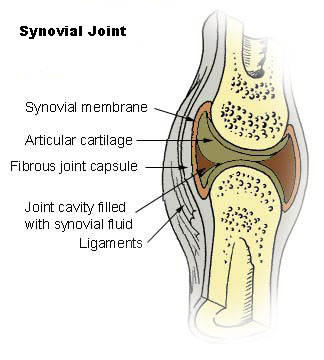A joint, also known as
an articulation, is a point where bones and cartilage come together. These
joints are important for holding the skeleton together and allowing for
movement.
 |
| Synovial joints |
Joints are classified
based on their movement and structure. There are three types of bones based on
the amount of movement they allow, including immovable, slightly movable, and
freely movable joints. In immovable and slightly movable joints, there is no
space between the bones.
On the basis of
structure, joints are classified into three types: fibrous joints,
cartilaginous joints, and synovial joints.
Fibrous joints are
immovable and held together by short fibers embedded in dense connective
tissue. Examples include sutures in the skull and the articulation of teeth
with the mandible and maxilla.
Cartilaginous joints
are slightly movable and are connected by hyaline or fibrocartilage, such as
the costal cartilages that connect the ribs to the sternum or intervertebral
discs.
Synovial joints are
freely movable and contain synovial fluid. These joints have a cavity
separating the bones, which is lined by a synovial membrane that produces
synovial fluid. Ligaments hold the bones in place, and menisci and bursae help
reduce friction. Examples of synovial joints include the knee and shoulder
joints.
There are six types of
synovial joints: hinge, ball and socket, gliding, ellipsoid, pivot, and saddle
joints. Hinge joints, like the elbow and knee joints, allow movement in one
plane or direction only. Ball and socket joints, like the hip and shoulder
joints, allow movement in various directions. Gliding joints only allow a
sliding movement, while ellipsoid joints are modified ball and socket joints
that allow movement in two directions. Pivot joints, like the articulation
between the axis and atlas, allow rotation around a single axis. Finally,
saddle joints allow movement in two directions and consist of two saddle-shaped
articulating surfaces, like the carpometacarpal joint of the thumb.
No comments:
Post a Comment